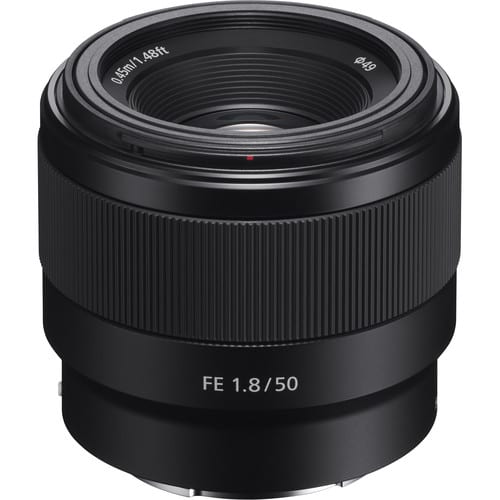- Total1.1K
- Facebook232
- Pinterest892
- Email12
Ditch the Kit Lens - Sharper Photos with More Bokeh Await You!

Overview
Every photographer remembers their first camera. If I had to guess, I’d say your first DSLR came with a kit lens, and you exhausted that thing until you were sure there was something better out there. As you’ve probably realized by now, there is. It’s called a prime lens, and if you want a well-rounded gear collection, here’s why you should add one to your camera bag today.

What’s the difference between zoom lenses and prime lenses?
Kit lenses are most often zoom lenses with a relatively narrow range of focus length. These really are great lenses for beginners, which is why they’re usually included with entry level models, but you’ll quickly outgrow them if you’re shooting regularly and are ready to level up the quality of your photos.
With zoom lenses, you can use the zoom ring on the outer circumference of the lens to adjust the focal length of your shot. Prime lenses don’t have zoom rings and instead have what’s called a fixed focal length. This means if you want to get closer to your subject, you’ll physically have to move closer to it. If you’re thinking this just sounds like an extra pain in the butt, I get it, but there’s a reason prime lenses are so well loved, especially by portrait photographers.

What makes prime lenses so great for shooting portraits?
When choosing a lens, the first thing to consider is the context in which you’ll be using it. Shooting a sports game? There’s a lens for that—you’ll want to go with a zoomable telephoto. Shooting landscapes? There’s a lens for that, too—definitely a good wide angle. For portraits, though, there’s no question that prime lenses are the best fit. Here’s why.
The first and most important reason to use a prime lens for portrait sessions is that they typically allow you to use a wider aperture, or smaller f-number, which gives you that crisp, clear subject and deliciously blurry background, so ideal for portraits. Think f/1.8 or f/2.0, versus the f/5.6 of a typical of kit lenses. Sure, there are a few zoom lenses that showcase a wider aperture, but they’re not cheap. The bottom line is, prime lenses lend to a beautiful, shallow depth-of-field that’s hard to achieve with zoom lenses. Portrait photographers can’t get enough of that bokeh.
Another common accolade awarded to the prime lens is its exceptional low light performance compared to most zoom lenses. The prime’s signature wide aperture allows more light into the camera. This allows for quicker shutter speeds, and thus, brighter, clearer shots. If you like to shoot at night or in dimly lit spaces, your prime lens will have your back.
Even photographers who shoot subjects other portraits can agree that prime lenses offer better image quality than zoom lenses. A sharper shot? Count me in, always. There are a few downsides to prime lenses, unfortunately, one being that they’re typically more expensive than zoom lenses. While they boast better image quality and low light performance, they’re less versatile than zoom lenses. You also need to consider that it’s not always ideal to be lugging around your collection of different primes when you’re on the move. Like I said, though, you can’t beat them if portraiture is your game. Once you shoot your first session with your brand new prime lens, I promise you’ll never go back to your zoom. It also doesn’t hurt that primes are much lighter than zoom lenses. That means weight literally lifted off your shoulders. Are you convinced yet?

Which prime lens is for you?
Prime lenses come in all shapes and sizes, literally. There are wide angle primes, like 18mm or 22mm lenses, and even telephoto primes, which range as high as 600mm. The focal length you’ll want will depend on how you intend to frame your shot, how far away from your subject you think you’ll be, and how much of the surrounding area you’re trying to capture. Regardless of your focal length of choice, there’s a prime lens out there that fits both your camera and your needs. For portraits the three most popularly used primes are also the best technical choices for portrait photography: 50mm, 85mm, 100mm and 135mm.
50mm: “The Nifty Fifty”
- Best for: Your first prime lens
- Price range: $100 – $900+
- Ideal shot style: Full-length and waist-level
- Beware: Distortion if too close to the subject
85mm: The most popular prime lens for portraiture
- Best for: A variety of shooting scenarios. Very versatile
- Price range: $200 – $3,000+
- Ideal shot style: Full-length, waist-level, and head-and-shoulders
- Beware: Facial distortion with headshots
100mm: Macro
- Best for: Sharp close-ups
- Price range: $300 – $700+
- Ideal shot style: Headshots
- Beware: Potential compression of facial features
135mm: Medium Telephoto – Great Portrait Lens (f/2)
- Best for: Sharp close-ups
- Price range: $800+
- Ideal shot style: Headshots
- Beware: Potential compression of facial features

My Lens Recommendations
To follow are my ‘Top Picks’ for best prime lenses for Sony, Canon and Nikon full-frame cameras like the Nikon D850, Canon EOS 6D Mark II and Sony a7.
I’ll cover my picks for APS-C (crop-sensor) cameras in an upcoming post. The smaller size of the sensor in these cameras creates a magnification factor of approximately 1.5 times the lens’ focal length. So, for example, a 50mm prime lens on an APS-C camera acts more like a 75mm lens does on a full-frame camera.

Canon Prime Lenses
- Canon EF 50mm f/1.8 STM
Price: $110.99 [BUY HERE]
Rental Price: $15 – 7 Days [RENT HERE] - Canon EF 85mm f/1.2L II USM
Price: $1,599.20 [BUY HERE]
Rental Price: $83 – 7 Days [RENT HERE] - Canon EF 100mm f/2.8L Macro IS USM
Price: $749.99 [BUY HERE]
Rental Price: $42 – 7 Days [RENT HERE] - Canon EF 135mm f/2L USM
Price: $999.99 [BUY HERE]
Rental Price: $45 – 7 Days [RENT HERE]

Nikon Prime Lenses
- Nikkor AF-S 50mm f/1.4G
Price: $449.99 [BUY HERE]
Rental Price: $28 – 7 Days [RENT HERE] - Nikkor AF-S 85mm f/1.8G
Price: $479.99 [BUY HERE]
Rental Price: $29 – 7 Days [RENT HERE] - Tokina 100mm f/2.8 AT-X M100 AF Pro D Macro
Price: $352.45 [BUY HERE]

Sony Prime Lenses
- Sony FE 50mm f/1.8
Price: $248.00 [BUY HERE]
Rental Price: $21.00 – 7 Days [RENT HERE] - Sony FE 85mm f/1.4 GM
Price: $1,798.00 [BUY HERE]
Rental Price: $104.00 – 7 Days [RENT HERE] - Sony 100mm f/2.8 Macro
Price: $798.00 [BUY HERE]
This post contains affiliate links. For more information, see our disclosures here.
If you’re ready to start pursuing YOUR photography dreams today, check out my FREE training that will equip you to Show Your Camera Who’s Boss. People who take my free training walk away a more confident camera user and better photographer. JOIN ME HERE!
- Total1.1K
- Facebook232
- Pinterest892
- Email12









6 thoughts on “Why You Need a Prime Lens in Your Camera Bag”
what is your opinion on using other compatible lenses on a particular brand camera. ie. using Tamron or Sigma lenses on a Canon or Nikon camera ?
Tamron or Sigmas work great!
I do alot of family photos. Which prime lens would you recommend? I shoot Canon.
Thanks!
a Nifty Fifty is always a great place to start, Jo!
What type of lens for wildlife and nature photography? I have a canon camera
Kim
Hello Kimberly, for wildlife and landscape photography I would look into the Canon EF 16-35mm f/4L IS USM or the Canon 24-70mm f/2.8L II USM. Both are quality wide-angle lenses that would work for either purpose.